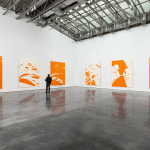
Contributed by Michael Brennan / Paul Mogensen dismisses the Renaissance. Not its considerable artistic achievements, of course, but rather its excessive emphasis within conventional art history. Mogensen is experiencing a renaissance himself with “Paintings: 1965-2022,” at Karma, a de facto mini-retrospective that includes 20 paintings and works on paper. Karma, a gallery known for its adventurous curatorial program and savvy publishing arm, has done a great deal more than most museums to sustain a variety of NYC-specific historical discourses since its inception in 2011. In the case of Mogensen, along with fabled colorist Robert Duran, Karma’s program is potentially the second coming of the legendary Bykert Gallery. This is a considerable achievement in a contemporary art world often characterized by “context collapse.”

Artists often use algorithms as tools to generate images, but with widely diverging results. Here, for instance, is a Joan Waltemath painting also derived by algorithms:

Mogensen also employs other ordering formulations. Paintings like no title (cadmium light yellow separated rectangles, three-part horizontal), 1967, a classic Mogensen, employ a kind of 3-2-1 downward reduction.

Others, such as no title (1974–1975), nod to the Golden Section, the basis for much composition throughout the history of Western art.

Mogensen’s painting is often described as blunt or Minimalist. Both are overworked terms. I particularly dislike “blunt” as a descriptor of his work because it can connote something worn or dulled – qualities I would never associate with Mogensen’s painting. His so-called bluntness is the result of directness, decisiveness, or, more simply, maturity. no title (2022) epitomizes the artist’s no-nonsense approach, which governs his more recent paintings.

Mogensen has a proclivity for making spirals, but not in any obvious or conventional manner. In this painting, the axial motion of a spiral is achieved in the most unlikely and blocky manner possible by painting small squares within a large one. Each interior square is incrementally enlarged in clockwise rotation. He arrived at the final product patiently and deliberately. Known for innovatively employing exquisite materials, Mogensen began the painting with a wash of acrylic alizarin crimson, inspired experiments with cerise ink on paper. Had he tried to replicate the cerise color in oil rather than acrylic, we’d all be waiting a lifetime for it to dry. He top-coated the crimson with ultramarine blue – straight from the tube, made glossy and more enamel-like with the addition of stand oil. These decisions are examples of Mogensen’s directness in both form and material. The painting’s essential beauty comes from a holistic aesthetic attitude rather than specific artistic adjustments; he would be loath to even the tone of semi-transparent ultramarine with a little bit of white.
One critic has described the mechanics of the blocky spirals in terms of the “push-pull” effect of advancing and receding color as described in Hans Hofmann’s famous pedagogy, much of which was lifted from Kandinsky. Their color does project, but Mogensen’s paintings are defined not so much by the “push-pull” effect as they are by circular movement and rotation, like the deployments of a volleyball team around an implied axis from station to station.
The blocky paintings are orthogonal cousins of Mogensen’s more explicit paintings of spirals.



See how they turn, turn, turn, mesmerizing in their chromatic intensity and efficiency.


no title, 1969, with its stark local color and distinctive linear quiver, perhaps has the most in common with the Pomo Indian Baskets, also native to California.
Because Mogensen’s approach is as much Constructivist as it is Minimalist, his work bears some similarity to other artists operating within the former paradigm.


Both no title (2022) and Aurélie Nemours’ N+H 918 can be described as squares within squares, but the intention and mechanics behind the two are entirely different. The direct incision of Mogensen’s squares in reminds me of metaphorical windows cut directly into adobe, which constitutes almost a sub-genre of abstraction.




Revisiting no title again for a second, one can see a common vocabulary with this example of Anglo-Saxon art.
Lastly, there are intriguing affinities between Mogensen’s masterful Copperopolis (1966) – which commands the back room of Karma’s larger gallery, incorporating the white wall between spaces as negative interval – and work by the artist’s friend and contemporary, David Novros. Here again, similar thinking at a particular time and place produced entirely different visual results.



Much like the recent “Roma/New York, 1953–1964” at David Zwirner, Karma’s Mogensen show is the kind of richly rewarding, intelligently curated exhibition one might have expected to see in a museum, in another era.
“Paul Mogensen: Paintings: 1965-2022,” Karma, 188 & 172 East 2nd Street, New York, NY. Through April 22, 2023.
About the author: Michael Brennan is a Brooklyn-based painter who writes on art.























Excellent article on Paul Mogensen’s wonderful work. Especially enjoyed the visual relationship to the Pomo basket
i have known paul since 1966. he is in our collection at the museum of friends here in walsenburg, co. we have three artists from the bykert gallery , paul mogensen, richard van buren and perter gorfain. check out our web site at museumoffriends.org brendt berger ,founder and co-creator
paul is one of three artists from the bykert gallery in our collection. richard van buren and peter gorfain are the other two. please check out our web site at http://museumoffriends.org i am sure you will see many others familiar to you. we are listed in art in america museum guide as the first museum of the counter culture.
we are proud of the fact that most of the art in our collection was gifted in friendship. we are both egalitarian and inclusive. sincerely, brendt berger
two artists from red hook brooklyn. maria cocchiarelli and i co created the museum of friends.
Excellent piece!
Great review-I would have loved to see the show as the paintings sound so necessarily physical..